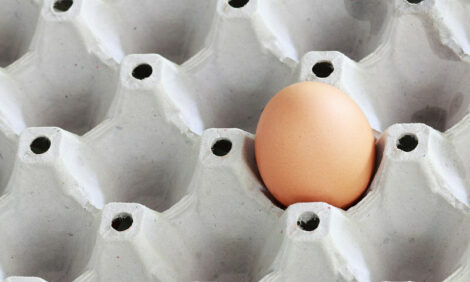



Evaluation of an Alcohol–Based Sanitiser Spray against Salmonella on Egg Processing Equipment
An alcohol–quaternary ammonium sanitiser solution were found by researchers in the US to be between 100 to 10,000 times more effective than water in reducing Salmonella numbers when it was sprayed on stainless steel beakers and packer head brushes.Improved sanitation procedures during shell egg processing may reduce the risk of food–borne illness. In a paper published recently in International Journal of Poultry Science, Michael T. Musgrove (Agricultural Research Service in Athens, Georgia) and J.K. Northcutt (Clemson University) report their experiments to determine the ability of an alcohol–quaternary ammonium sanitiser or water to reduce Salmonella inoculated onto stainless steel and shell egg processing equipment.
A nalidixic acid-resistant Salmonella typhimurium (ST) isolate was grown on agar plates at 37°C for 18 to 24 hours. Cells were harvested and added to Phosphate Buffered Saline (PBS) to generate 8.5 Salmonella cells per mL inoculum in two experiments. Both experiments were repeated twice.
In the first experiment four stainless steel beakers were contaminated by spraying 10mL of inoculum, respectively. Beakers were allowed to dry for 15 minutes. Two of the beakers were sprayed with 20mL of water and the other two were sprayed with a sanitiser solution (70 per cent isopropyl alcohol and 200ppm quaternary ammonium). After five minutes and 24 hours, each beaker was swabbed with a PBS–moistened sponge and plated onto BGS supplemented with 200ppm nalidixic acid to enumerate surviving ST.
In the second experiment, inoculum was sprayed onto two brushes from shell egg packing machinery. After 15 minutes, one brush was sprayed with water for five minutes and the other was sprayed with the sanitiser for 30 seconds. Each brush was sampled by swabbing three times after five minutes and 24 hours.
After five minutes, 5.5 and 0.6 log colony–forming units (CFU) per mL ST and after 24 hours, 2.8 and 0.0 log CFU per mL ST were recovered from stainless steel, respectively. Packer head brush average results were 4.7 and 3.1 log CFU per mL ST after five minutes and were 4.0 and 0.00 log CFU per ml ST after 24 hours.
This sanitiser solution and delivery system were 100 to 10,000 times more effective than water in reducing Salmonella numbers, concluded Musgrove and Northcutt.
They added that, on most of the equipment used in commercial facilities, the packer head brushes are very difficult to reach, requiring disassembly of machinery to access the entire set of brushes. Spraying with tap water may be the only cleaning or sanitising step that is observed daily for packer head brushes, though some facilities remove and soak another set of brushes on a weekly basis. The sanitation system used in this study would allow reaching the brushes without disassembly, making it possible to sanitise daily.
Reference
Musgrove M.T. and J.K. Northcutt. 2012. Evaluation of an alcohol–based sanitizer spray’s bactericidal effects on Salmonella inoculated onto stainless steel and shell egg processing equipment. International Journal of Poultry Science, 11(2): 92-95.
Further Reading
| - | You can view the full report by clicking here. |
May 2012








